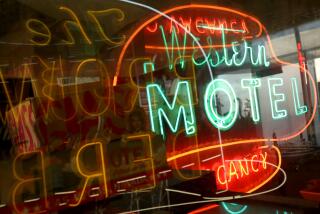All Dolled Up : The Bowers Museum Puts Antique Toys on Parade
- Share via
She’s perfect, a real doll. With a tiny rosebud mouth, a hint of pink in her round cheeks and a wisp of tawny hair, she rests sweetly in her cradle in a Bowers Museum gallery.
This little babe is actually an original Bye-lo baby doll, one of more than 70 dolls and toys being featured in Bowers’ “Little Men, Little Women: A Century of Dolls” exhibit through Sept. 25. It features dolls from 1830 to 1930 and represents some of the finest toy makers from Germany (the world’s largest toy manufacturer until World War II), France and the United States.
Presented in cooperation with the Verdugo Hills Doll Club of Los Angeles, it includes dolls of every shape and size--from tiny, luxuriously dressed “peg woodens” similar to those Princess Victoria played with, to child-size dolls with features of glowing bisque porcelain. In between are boy dolls from the ‘20s dressed in snazzy yellow Angora and pleated pants; a turn-of-the-century mechanical doll in rollerskates and a velvet skating suit; a 1906 bisque fashioned by Madame Helena Modjeska (as in Orange County’s own Modjeska Canyon), and a mint-condition Shirley Temple doll from the 1930s, to name just a few.
Each has been painstakingly restored, researched and catalogued with the help of volunteers from the Verdugo Hills club. The cooperative project has been in progress since 1986 and dovetails with the United Federation of Doll Clubs convention in Anaheim from Aug. 15 to 19.
Guest curator Dottie Baker, a club member who clocked hundreds of hours preparing the exhibit, is quick to stress that the value of these dolls goes far beyond their aesthetic appeal. “Dolls are more than just pretty faces,” said Baker, who is considered one of the Southland’s top doll experts. “They can lead us in so many different directions. They’re a diminutive reflection of the living world . . . telling us about the artistry, the culture, the fashions of a given point in time. It’s like a wonderful lesson in history.”
Baker, who specializes in the historical development of dolls from 1700 through 1920, says the Bowers collection includes some of the finest examples of historical dolls in the country. But it was the Bye-lo that really turned her head.
“This Bye-lo is the most perfect commercial wax doll I’ve seen,” she said. “As far as I know, there are only 19 of them in existence, so the collectors are quite frankly in a tizzy about her.”
But collectors are not the only ones who can appreciate the Bowers exhibit, Baker said. “There’s a certain charm to this show that I think will strike a responsive chord in everyone who sees it. It’s not just a random collection of toys. It has warmth.
“I think today’s toy shops are like grocery stores, just a lot of items stacked on the shelves. Here, you instantly feel a kind of enchantment and wistfulness . . . when you realize that something this lovely can exist in today’s world. Many of them are as fine as haviland china or grandmother’s Dresden figurines. And they’re just as much a part of our own artistic history.”
“Little Men, Little Women: A Century of Dolls” continues at the Bowers Museum, 2002 N. Main St., Santa Ana, through Sept. 25. Hours: 10 a.m. to 5 p.m. Tuesdays through Saturdays, noon to 5 p.m. Sundays. Admission: free. In conjunction with the exhibit, a series of doll-related presentations is being scheduled, including classes in doll making for children and adults. Information: (714) 972-1900.
More to Read
Sign up for The Wild
We’ll help you find the best places to hike, bike and run, as well as the perfect silent spots for meditation and yoga.
You may occasionally receive promotional content from the Los Angeles Times.






